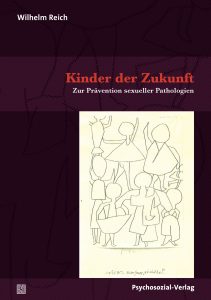by Andreas Peglau

In December 1929, Reich and Freud exchanged blows at one of the discussion evenings organized by the latter in Vienna. The central point was Reich’s conviction that prophylaxis of sexual and
neurotic disorders was as necessary as it was possible – a view that Freud had also held, but in earlierer times. Now, however, Freud vehemently opposed Reich’s theses, qualifying them as allegedly „completely unpsychological.“
Children of the Future can be read as a balance sheet of what Reich opposed to Freud in his remaining life span in research and practical activity.
For this book is not a late work by Reich, but a posthumous compilation first published in English in 1983.
It includes – in each case under a modified title, partly with changes in the text – the essay „Über Onanie im Kindesalter“ (On Onanism in Childhood), published in 1928 in the Zeitschrift für psychoanalytische Pädagogik , the book Der sexuelle Kampf der Jugend (The Sexual Struggle of Youth) published in 1932, as well as „Gespräch mit einer venünftigen Mutter“ (Conversation with a Reasonable Mother) published in 1936, and an excerpt from the interview Reich gave to K.R. Eissler about Freud in 1952.
The main part, however, is in fact Reich’s remarks, which he originally intended to present in book form.
In 1949 he had founded the Orgonomic Research Center for Children (OIRC). The inspiring background for this was, on the one hand, his ongoing criticism of common educational methods: As early as 1926, his article „Der Erziehungszwang und seine Ursachen“ (The Educational Compulsion and its causes) can be found in the Zeitschrift für psychoanalytische Pädagogik.
On the other hand, he had become a father once again in 1944 and was now able to establish a more loving relationship with his son Peter than he had been able to do with his daughters born in the 1920s.
In addition, there was the intensive exchange of ideas with his friend, the Scottish educator A.S. Neill, founder and leader of the Summerhill-School.
Reich saw the following research priorities for OIRC:
- Prenatal care of mothers/
- Observation and professional support during birth and the first days of life/
- Prevention of psychological and psychosomatic disorders up to the sixth year of life/
- Recording of life history beyond puberty.
He was already able to refer to individual cases. The most precise of which he presented here – anonymously – was his son Peter, which allows insights into Reich’s very personal understanding of education.
At the same time, he dealt with a question that is still mostly ignored today: How can psychologically and psychosomatically healthy babies and toddlers be identified?
Here he anticipated much of what is now being discussed in the context of prenatal and perinatal psychology or under the heading of „natural birth“.
Once again Reich showed the inseparable causal connection between early life phases, later individual and social (mis)developments. William Steig, creator of the „Shrek“ character, who also created illustrations for Reich, writes in the preface:
„In this world where nations are constantly making preparations to wipe each other out and perhaps even the entire planet, (…) anything that can help us understand how we got into this horrible situation should be enthusiastically examined.“
Children of the Future should therefore be read by anyone interested in pregnancy, childbirth, mental and psychosomatic health and disorder, children, education, neurosis origins and prevention – or simply in information about how they themselves and our society became the way they are today.
At the end of 2017 – in the year of Wilhelm Reich’s 120th birth anniversary and 60th death anniversary – this book was published for the first time in German by Psychosozial-Verlag Gießen.
Slightly modified (and translated by DeepL) version of a review first published in Luzifer-Amor. Zeitschrift zur Geschichte der Psychoanalyse, issue 61 (2018).

